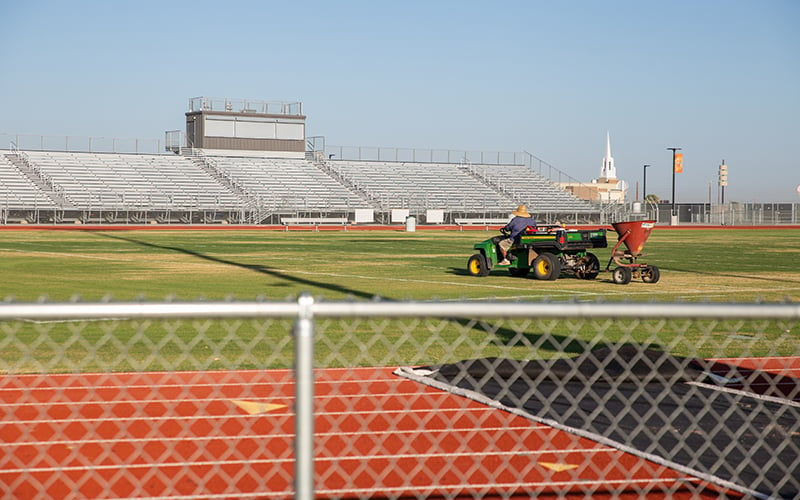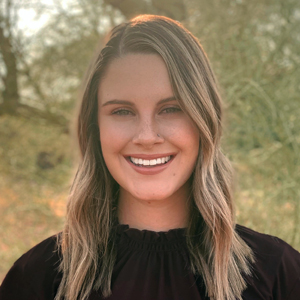
As high schools, including Mesa’s Eastmark, prepare to kick off the football season, rules are in place for fan attendance during the COVID-19 era. (Photo by Allie Barton/Cronkite News)
PHOENIX – Once it was decided that high school football games would be played in Arizona amid the COVID-19 pandemic, the next decision to be made was whether fans would be allowed to fill stadiums.
That decision was left up to each school district, which will base decisions on the COVID-19 numbers in its area.
The AIA Sports Medicine Advisory Committee announced on Sept. 17 that the ability to safely participate in football activities would depend on if a district or county has no more than 75 positive COVID-19 cases per 100,000 people. The original recommendation was no more than 10 positive COVID-19 cases per 100,000 people.
Here’s a breakdown of a few districts and their rules for fan attendance:
Tempe Union High School District
The district will permit two tickets per athlete.
District athletic director David Huffine and the district school board are also implementing safety protocols for fans, and plan to enforce social distancing.
“We’re going to do temperature checks for every fan that comes in … concession stands are not going to be open. … We’re going to have restrooms open to the public, but we’re going to monitor that with security. One person per restroom,” Huffine said. “We’re going to set up the gym and the stadium so that there will be social-distancing marks so that people can understand where they need to sit. And they have to understand that’s where we are going to require them to stay.”
The board came to this decision by sticking to the numbers. With COVID-19 positive tests still high in their district and students still attending classes remotely, they agreed that limiting the number of fans is the safest option under current circumstances.
With their schools being near Arizona State University, the metrics become more difficult to track. However, the district is also hoping that as COVID-19 cases decrease, they can allow for more fans to attend. Their aim is to open attendance up to 25 or 50 percent in the future.
For now, Huffine is excited to get athletes on the field and start the sports season.
“Our whole goal is to let them play,” he said. “Let their families see as much of the games as possible. I want to open it up as soon as possible. And when it’s safe we’re certainly going to look forward to doing so.
“I do know that families want to come out and bring as many people. I’d love to see a packed stadium right now. Unfortunately that is not necessarily the safest way of going about things and we certainly recognize that as well.”
Mesa Unified School District
The district is permitting four tickets per athlete.
Like other districts, Athletic Director Steve Hogen and the district school board are taking their own precautions for fan attendees. While there won’t be any volunteers, there will be security guards. There will also be tape to guide fans on where they can sit to practice social distancing.
“We’ve sent out information and we’ve taped off the bleachers in sections of 6 feet or 8 feet. We created pod type things, so that blue painters tape put it down for 6 feet, then a gap. And then do the same thing, then skip a row, then alternate,” Hogen said.
For ticket sales, Mesa is using one of the largest high school ticketing services, Gofan. Fans can go to the website and purchase their game tickets electronically.
While the district worked to satisfy the fans, the current fan attendance regulations are subject to change as the district sees fit in the coming weeks.
“It’s always changing,” Hogen said. “It’s fairly fluid. So we’re not necessarily locked in. We just felt these first couple games we wanted to kind of make sure we had a good handle on everything. On how to seat them, distance them, make sure that they would wear their masks, and do the things that we’re asking them to do. Yet, we want to make sure they’re there to see their kids play.”
Scottsdale Unified School District
The district is permitting two tickets per athlete.
Students and coaches in Chaparral’s district are disappointed with the limit on fan attendance but are excited that they get to play their sport.
For some athletes, it’s their senior year and the last time that they will take the field. Chaparral senior Jack Whitten will miss the environment but knows the importance of being permitted to play this season.
“It’s disappointing,” Whitten said, “because we’d like to have a lot more people there to bring a lot more energy in the stadium, and I’ve got grandparents who have never missed a game before and now they’re going to miss games because they’re not going to be allowed. So it’s sad, but the most important thing is that we play.”
Saguaro coach Jason Mohns is frustrated about fan attendance regulation, but he is excited that his team gets to take the field.
“We open up the season with Chaparral,” Mohns said. “That’s usually just an incredible environment. It’s exciting. But at the end of the day they are playing football. Important games with a lot on the line. They’re going to be ready to go. It won’t be the same but I dont think it’s going to affect our ability to line up and get up for important games.”
As the season goes on, if the COVID-19 numbers decline, districts will consider changing their attendance limits to best follow the guidance and recommendations from the Arizona Health Department and other sources.




